1. Origin and meaning of Parvati
Parvati is the daughter of the Himalaya parvat (Mountain) or one who has undertaken austerities atop a mountain.
2. Some other Names
-
Parvati : Names such as Parvati, etc. came into usage after the merging of the Shaiva (Worshippers of Shiva) and Shakta (Worshippers of Shakti) Tantras. Before this, She was named variously as Aditi, Sundari, Surasundari, Pattambara (One adorning red clothing), Shvetambara (One in white attire), Nilambara (Dressed in blue) etc.
-
Gouri : Gour means the radiance acquired through austerities. After Parvati performed intense austerities to receive a blessing from Shiva, She acquired radiance. It is because of this that She came to be known as Gouri.
-
Karali : The word Karali has formed thus – ‘Kar + Ali’. ‘Kar’ means hands and ‘ali’ means rows. One who has rows of hands is Karali. ‘Kar’ also means one who works with the hands. Shakti that exhibits rows or lines of work or one that accomplishes multiple missions is Karali. The prevalent meaning of Karali is ‘terrible’. If an energy accomplishing multiple missions is to be pictorially depicted, then an artist will depict it in the human figure with multiple hands. Seeing a woman having four, eight or ten hands will frighten everybody. Therefore, Karali means ‘terrible’ became prevalent.
-
Aparna : Aparna constituted by ‘a’ and ‘parna’ refers to one who performed austerities without eating even a parna (Leaf).
-
Uma : This is a mild form of Parvati, the daughter of Himalaya. The origin of the word Uma is as follows –
उं शिवं माति मिमीते वा । – Shabdakalpadrum
Meaning : U (उ) means Shiva. The one who measures Him is Uma.
- यतो हि तपसे पुत्रि वनं गन्तुं च मेनका ।
उमेति तेन सोमेति नाम प्राप तदा सती ॥ – Kalikapurana, 42Meaning : A daughter desirous of going to the forest to perform austerities was advised by Menaka (Her mother), a celestial beauty, “O, U (Girl) ma (Do not go for penance)”. Hence, She was named Uma.’
-
Shubhada : ‘शुभं ददाति इति ।’ means one who bestows propitiousness is Shubhada.
3. Unique characteristics and mission
-
Non-duality : Non-duality with Shiva. She married Shiva first as Sati and later as Parvati.
-
Desirous to learn Spirituality (Also known as jidnyasu) : In the Puraṇas, Parvati is portrayed as a woman extremely curious about Spirituality. To acquire the Shiva Principle concealed in various objects in the universe, She asks Shiva several questions and Shiva narrates to Her different kinds of vrats (Vowed religious observance) and stories associated with them. The vows and religious obligations performed by women have stemmed from the conversations between Shiva and Parvati.
-
Compassionate : Parvati is an icon of compassion. She is instantly moved by the grief of the poor and the downtrodden. She hears the anxious call of the distressed even before Shiva does. She then awakens Shiva from His samadhi and requests Him to accompany Her in rushing to the rescue of the one distressed.
-
Marak-shakti (Destroyer energy) : This form is fearsome and terrifying. During the slaying of the demons Chanda-Munda and Mahish, this form manifested suddenly. Shiva becomes functional solely due to this form of Shakti.
-
Non-duality between Shiva and Shakti : Parvati is not just a part of the retinue, but is the consort of Shiva. She acquired the name Shakti in the Shaiva doctrine and thus the union of Shiva and Shakti was established. Gorakshanath has expressed their oneness in the following shloka –
शिवस्याभ्यन्तरे शक्तिः शक्तेरभ्यन्तरे शिवः ।
अन्तरं नैव जानीयाच्चन्द्रचन्द्रिकयोरिव ॥ – Gorakshasiddhanta SangrahaMeaning : Shakti resides in the heart of Shiva and vice versa. Just as the moon and its light are inseparable, so are Shiva and Shakti. One should not consider them as separate.
4. Science underlying the Idol
The Holy texts Kashyapashilpa and Manasar describe how an Idol of Parvati should be sculpted. They state – by Herself, Parvati should be portrayed with four arms and when beside Shiva, She should have two arms.
When alone, a crown of matted hair should adorn Her head. The two upper arms should hold a lotus and a noose and the two lower arms should be in a posture bestowing a blessing (known as Varadamudra) and in a posture depicting protection (known as Abhayamudra). When accompanying Shiva, She should be seated on a lotus or standing embellished with ornaments. Her right hand should hold a lotus and the left should be straight by Her side.
5. One of the forms of Parvati – Durga
5A. Origin and meaning of Durga
- दैत्यनाशार्थवचनो दकारः परिकीर्तितः ।
उकारो विघ्ननाशस्य वाचको वेदसम्मतः ।
रेफो रोगघ्नवचनो गश्च पापघ्नवाचकः ।
भयशत्रुघ्नवचनश्चाकारः परिकीर्तितः ॥ – Brahmavaivartapuran, Adhyaya 27, Shloka 18,19Meaning : According to the Vedas, the alphabet ‘da’ in Durga suggests destruction of demons. The ‘u’ has been accepted to represent over coming of obstacles. The half ‘ra’ signifies elimination of disease, ‘ga’ nullification of sins and ‘a’ the overcoming of fear and destruction of enemies.
-
When She killed demon Durg, She was called Durga.’
-
‘Dur’ in Durga means evil and ‘ga’ means remover or destroyer. Hence, Durga means the one who destroys the evil.
-
Formerly in different regions, various Devis were worshipped with several Names. The authors of the Puranas merged all these Devis into one, called Her Durga and accorded Her the status of the consort of Shiva.
5B. Unique characteristics and mission
-
Slaying powerful demons such as Mahishasur, Chanda-Munda and Shumbh-Nishumbh, Durgadevi emerged as Mahashakti (Supreme Shakti) and assured protection to all Deities and man. When the Deities praised Her, She said,
इत्थं यदा यदा बाधा दानवोत्था भविष्यति ।
तदा तदाऽवतीर्याहं करिष्याम्यरिसंक्षयम् ॥ – Markandeyapurana, 91.51Meaning : Whenever there is harassment (of the world) by demons in this way, I will incarnate and destroy them !
-
There is also a spiritual form of Durga beyond Her physical form. In that form, She liberates devotees from the web of Maya and attachment and bestows them with self-realisation. She Herself has described this spiritual form of Hers thus –
सर्वे वै देवा देवीमुपतस्थुः । काऽसि त्वं महादेवि ।
साऽब्रवीदहं ब्रह्मस्वरूपिणी । मत्तः प्रकृतिपुरुषात्मकं जगच्छून्यं चाऽशून्यं च ।
अहमानन्दाऽनानन्दाः विज्ञानाविज्ञाने अहम् । ब्रह्मा ब्रह्मणी वेदितव्ये ॥ – Devyupanishad, Khanda 1Meaning : All the Deities appeared before Devi and asked Her, “O Mahadevi (Supreme one), who are you ?” She replied, “I am Brahmanswarupini, a form of Brahman. This universe composed of the Prakruti (Primeval Nature) and the Purush (Absolute Being) and the unmanifest and manifest universe has been created from me. I am both, Anand (Bliss) and Niranand (Lacking in Bliss), ignorance and knowledge and also non-Brahman and the Brahman worthy of realisation”.
5C. Science pertaining to the Idol
Shri Durgadevi is depicted in various forms having four, eight or ten hands, etc.
Shri Durgadevi through the subtle dimension suggested the symbolic meaning of the various body parts in Her picture.
| Part of picture | What does it signify ? | Part of picture | What does it signify ? |
|---|---|---|---|
| 1. Six weapons | Destruction of the six foes | 5. Shield | Grace of Guru |
| 2. Vessel with fire | Warrior attitude | 6. Lifted foot | Destruction of ego |
| 3. Severed head | Raja, Tama, evil attitude | 7. Left foot | Surrender |
| 4. Japamala | Devotion |
6. One of the forms of Parvati – Kali
6A. Definition
-
In the Holy text Pranatoshini the definition of Kali is as under :
कालसङ्कलनात् काली सर्वेषामादिरूपिणी ।
कालत्वादादिभूतत्वादाद्या कालीति गीयते ॥Meaning : Kali activates the time and is the basis of all Creation. With reference to Kal (Time), the five Cosmic Principles and living beings, Kali is the first to manifest Herself. Kali is called so because Kal itself is Her foundation, and She has existed since times immemorial.
-
The text Tantralok defines Kali as is given ahead.
काली नाम पराशक्तिः सैव देवस्य गीयते ।
Meaning : The Supreme Energy of Brahman which is the kriyashakti (Energy of action) is itself known as Kali.
6B. Unique characteristics and mission
Kali dances upon the chest of Mahakal, that is, Shiva. In the Kalivilas Tantra, She is also called Shavasana or Shavarudha. In the Path of Tantra, both, a shav (Corpse) and Shiva are names of the same Principle. The first manifest form of the formless Brahman is shav. It is motionless. When vibrations of energy are generated in it, it is activated to create the universe and is referred to as Shiva. In other words, Brahman devoid of Shakti is a shav and Brahman along with Shakti is Shiva. The ‘i’ in Shiva represents Shakti. He being the support of the Divine play of the Mahashakti (Supreme Shakti), is known as Shavasan. ‘Hesauho (हेसौः)’ is the bij of a corpse and is known as a shavabij or a pretbij. At the time of Creation, this corpse assumes the form of a padma (Lotus) and becomes the asan (Seat) or site of Divine play of Mahamaya Kali. This is known as Kali’s mahapret-padmasan (The great lotus seat of the corpse). The same meaning has been conveyed in the shloka ahead.
प्रेतस्थां च महामायां रक्तपद्मासनस्थिताम् । – Kalivilas Tantra (27)
Meaning : Devi Kali, seated on the red lotus, is the form of Mahamaya (Great Illusion). She bestows the corpse, that is, the inactive Brahman with chetana.
6C. Implied meaning of unique features of Kalimata’s form
| Unique features | Implied meaning |
|---|---|
| 1. Severed head of the demon Mahishasur | Destruction of ignorance or temptation |
| 2. A garland of severed heads around the neck (52 in number according to the Karpuradi stotra 50 according to the Niruttar-tantra) | Alphabets represent the Shabdabrahma |
| 3. A girdle of arms severed from corpses and tied around the waist | The severed hands represent their liberation from willful actions |
| 4. Dance in the crematorium | Crematorium refers to the heart of the seeker who is free from desire, and dance refers to Anand (Bliss) |
Reference : Sanatan Sanstha’s Holy text ‘Shakti (Part 1) Introduction to Divine Energy’ and ‘Shakti (Part 2) Worship of Divine Energy’

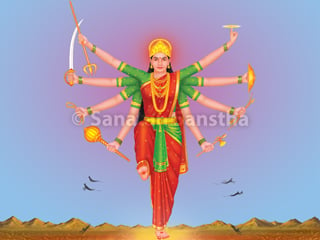
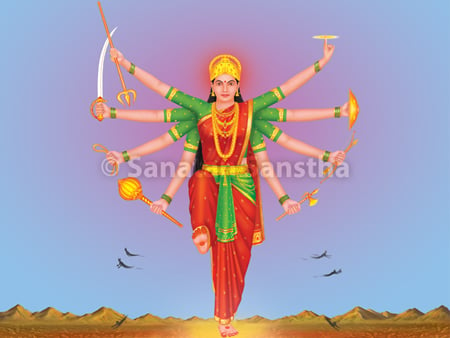
 Frequently Asked Questions on Kuladev and Kuldevi
Frequently Asked Questions on Kuladev and Kuldevi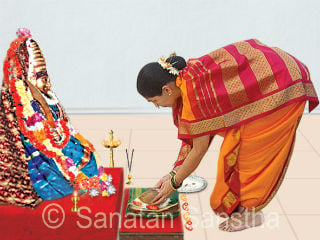 What is importance of 'offering a sari' for the Goddess?
What is importance of 'offering a sari' for the Goddess?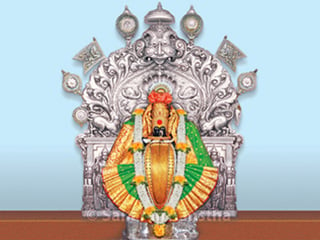 Seats of Shakti (Shakti-peeth)
Seats of Shakti (Shakti-peeth)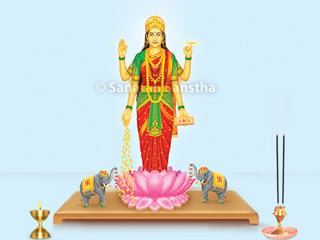 Shakti Worship
Shakti Worship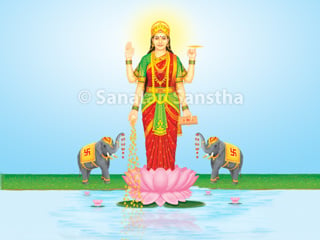 Shakti associated with Shrivishnu - Shri Lakshmi
Shakti associated with Shrivishnu - Shri Lakshmi